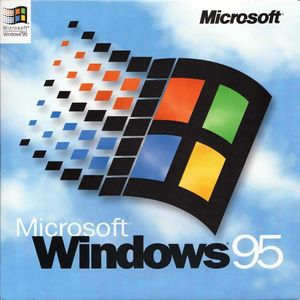Windows 95: Difference between revisions
(Created page with "{{Infobox_Software | software_name = Windows 95| software_image = 300px| developer = Microsoft| publisher = Microsoft| systems = x86, IA-32| release = 95: August 15, 1995<br />95 OSR1: February 14, 1996<br />NT 4.0: July 31, 1996<br />95 OSR2: August 24, 1996<br />95 OSR2.1: August 27, 1997<br />95 OSR2.5: November 26, 1997<br />98: May 15, 1998<br />98 SE: May 5, 1999<br />Me: Jun...") |
(fix categories) |
||
| Line 22: | Line 22: | ||
The Windows 9x series ran DOS programs through a DOS-based Virtual DOS Machine. 16-bit Windows applications were run through a compatibility layer known as Windows on Windows. | The Windows 9x series ran DOS programs through a DOS-based Virtual DOS Machine. 16-bit Windows applications were run through a compatibility layer known as Windows on Windows. | ||
[[Category: | [[Category: Operating systems]] | ||
[[Category: | [[Category: Operating systems developed by Microsoft]] | ||
[[Category: | [[Category: Operating systems published by Microsoft]] | ||
[[Category: | [[Category: Operating systems released in 1995]] | ||
[[Category: Windows]] | [[Category: Windows]] | ||
Latest revision as of 17:02, 11 August 2023

| |
| Windows 95 | |
| Developer | Microsoft |
|---|---|
| Publisher | Microsoft |
| Platforms | x86, IA-32 |
| Released | 95: August 15, 1995 95 OSR1: February 14, 1996 NT 4.0: July 31, 1996 95 OSR2: August 24, 1996 95 OSR2.1: August 27, 1997 95 OSR2.5: November 26, 1997 98: May 15, 1998 98 SE: May 5, 1999 Me: June 19, 2000 |
| Added to Museum |
Windows NT Workstation 4.0: May 15, 2020 |
Windows 95 is the beginning of Windows 9x, a group of operating systems that constitute the fourth iteration of the Windows product line by Microsoft.
It is a hybrid 16-bit and 32-bit operating system. The boot stage is based on MS-DOS.
Features
The Windows 9x series featured a new streamlined GUI, with a taskbar, a start menu to quickly load applications, and a recycling bin icon and associated app that would hold files to be deleted and would delete them from the computer upon emptying the recycle bin.
Windows NT 4.0 introduced the Windows 9x interface to the Windows NT line.
Compatibility
Windows 95 and its OEM Service Releases, Windows NT 4.0, Windows 98, Windows 98 Second Edition, and Windows Millenium Edition relied on DOS but had a 32-bit protected mode driver instead of the standard 16-bit driver to allow for 32-bit disk access.
The Windows 9x series ran DOS programs through a DOS-based Virtual DOS Machine. 16-bit Windows applications were run through a compatibility layer known as Windows on Windows.